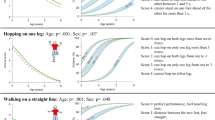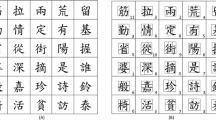Abstract
Testretest reliability and intellectualbehavioral correlates of a revised version of the Physical and Neurological Examination for Soft Signs (PANESS) were evaluated. The WISC-R and PANESS were administered to a heterogeneous clinical sample of 28 6-to 8-year-old children. Test-retest interval for PANESS retest was approximately 28 days with 15 children retested by same testers and the remaining children retested by different testers. Results indicated that PANESS total score is a reliable indicator of overall performance; tester assignment and retest had negligible effects on total score. Grade of subcategory scores proved unreliable across examiners but occurrence/nonoccurrence scores were more robust. Performance on the PANESS was significantly correlated with WISCR indices sensitive to brain dysfunction, and behavioral factors implicated in the description of minor neurological dysfunction. Further research evaluating discriminant validity of the examination and changes in performance as a result of development is recommended.
Similar content being viewed by others
References
Camp, J. A., Bialer, I., Press, M., & Winsberg, B. C. The physical and neurological examination for soft signs (PANESS): Pediatric norms and comparisons between normal and deviant boys.Psychopharmacology Bulletin, 1977,13, 39–41.
Camp, J. A., Bialer, I., Sverd, J., & Winsberg, B. G. Clinical usefulness of the NIMM physical and neurological examination for soft signs.American Journal of Psychiatry, 1978,135, 362–364.
Close J. Scored neurological examination.Psychopharmacology Bulletin: Special Issue, Pharmacotherapy of Children, 1973, 142–148.
Duncan, O. D. A socioeconomic index for all occupations. In A. J. Reiss (Ed.),Occupations and social status. New York: Free Press of Glencoe, 1961.
Foster, R. M., Margolin, L., Alexander, C., Benitez, O., & Carr, F. Equivocal neurological signs, child development, and learned behavior.Child Psychiatry and Human Development, 1979,9, 28–32.
Goyette, C. H., Conners, C. K., & Ulrich, R. F. Normative data on revised Conners parent and teacher rating scales.Journal of Abnormal Child Psychology, 1978,6, 221–236.
Kaufman, A. S.Intelligent testing with the WISC-R. New York: Wiley, 1979.
McMahon, S. A., & Greenberg, L. M. Serial neurologic examination of hyperactive children.Pediatrics, 1977,59, 584–587.
Mikkelsen, E. J., Rapoport, J. L., Nee, L., Gruneau, C., Mendelson, W., & Gillin, J. C. Childhood enuresis I: Sleep patterns and psychopathology.Archives of General Psychiatry, 1980,37, 1139–1144;Psychopharmacology Bulletin, Pharmacotherapy of Children, Special Issue, 1973.
Reitan, R. M. Psychological effects of cerebral lesions in children of early school age. In R. M. Reitan & L. A. Davison (Eds.),Clinical neuropsychology: Current status and applications. Washington, D.C.: Winston, 1974.
Reitan, R. M., & Davison, L. A. (Eds.).Clinical neuropsychology: Current status and applications. Washington, D.C.: Winston, 1974.
Selz, M., & Reitan, R. M. Rules for neuropsychological diagnosis: Classification of brain function in older children.Journal of Consulting and Clinical Psychology, 1979;47, 258–264.
Shekim, W. O., Dekermenjian, H., & Chapel, J. L. Urinary MHPG excretion in minimal brain dysfunction and its modification by d-amphetamine.American Journal of Psychiatry, 1979,136, 667–671.
Wechsler, D.Wechsler Intelligence Scale for Children-Revised. New York: Psychological Corporation, 1974.
Wender, P. H.Minimal brain dysfunction in children. New York: Wiley, 1971.
Werry, J. S. Organic factors. In H. C. Quay & J. S. Werry (Eds.),Psychopathological disorders of childhood (2nd ed.). New York: Wiley, 1979.
Werry, J. S., & Aman, M. G. The reliability and diagnostic validity of the physical and neurological examination for soft signs (PANESS).Journal of Autism and Childhood Schizophrenia, 1976,6, 253–262.
Author information
Authors and Affiliations
Additional information
The authors wish to thank Clint Bowers, Melissa Commander-Hodo, Debra Drewry, Elizabeth Evans, Alyson Forbes, Lisa Hinson, Pamela Moore, and Susan Moore for their assistance.
Rights and permissions
About this article
Cite this article
Holden, E.W., Tarnowski, K.J. & Prinz, R.J. Reliability of neurological soft signs in children: Reevaluation of the PANESS. J Abnorm Child Psychol 10, 163–172 (1982). https://doi.org/10.1007/BF00915938
Revised:
Issue Date:
DOI: https://doi.org/10.1007/BF00915938




